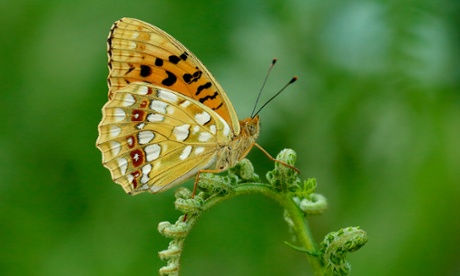By any standards, it was a poor day to count butterflies. Denbies Hillside, on the south-facing flank of the North Downs – supposedly a summer haven for lepidopterists – was swept by wind and heavy showers. Butterflies, like humans, take a poor view of such conditions and had made themselves scarce.
Such are the discomforts of involvement in the Big Butterfly Count. The national survey has seen thousands of members of the British public counting butterfly species across the nation. It has been a damp and cold process on occasion.
I had joined Richard Fox of Butterfly Conservation, which runs the big count, on Thursday to try to spot silver-spotted skippers, a relatively rare species that has recently bucked long-term decline and enjoyed a revival in numbers on southern England’s chalkland heaths. We saw none.
On the other hand, we did spot several members of more numerous species flittering around the vetch and wild marjoram on Denbies hill. These included chalk hill blues, small heaths, gatekeepers, meadow browns, common blues, red admirals and – intriguingly – a six-spot burnet moth. The six-spot is especially interesting because it sports bright red and black wings, a warning to predators that it contains unhealthily high levels of cyanide. It acquires the poison in its caterpillar stage, by eating a species of wildflower called bird’s-foot trefoil. For Fox, the tally was reasonable, given the weather. “However,” he said, “what will happen when the count is completed is hard to say. We’ve had some grim weather since its launch in July.”
The count is important because butterflies are a litmus test of the ecological health of Britain. “Butterflies are beautiful and we imbue them with all sorts of cultural significance. They represent hopeful transformation, from grub to a lovely, iridescent flying creature. We take great notice of them – unlike other insects.”
Only 59 species of butterfly are found in the UK, while there are 25,000 species of other insects. “Apart from specialists and biologists, no one cares about these other creatures – the wasps, beetles, ants, weevils, and all the other creepy crawlies that make up the nation’s insect population,” said Fox.
But we do take notice of butterflies – and that makes them important. “By tracking their fortunes, we can get a feeling for what is happening to the rest of the insects in Britain,” he said. “The changes in farming, atmospheric conditions, climate and other factors that affect butterflies also tend to affect all our insects, and that, in turn, gives us an indication of the general ecological health of the nation.”
So how well are our butterflies doing? Not well is the simple answer. Surveys carried out in the UK in recent decades have shown serious declines in most species, with numbers tumbling for many thought to be widespread. Examples include the Essex skipper and small heath butterflies. Overall, 70% of species have declined in occurrence and 57% have declined in abundance since 1976.
The growth in intensive agriculture has had a particularly pernicious impact on numbers, say biologists. Throughout the 20th century, meadows of mixed grasses and wildflowers have been ploughed up and single crops, usually wheat or barley, planted in their place. In this way individual species of caterpillar that thrived on a particular plant, such as horseshoe vetch, bird’s-foot trefoil, sheep’s sorrel or kidney vetch, had nothing to eat and started to disappear. Numbers of our chalk hill blues, gatekeepers and other butterflies plummeted in their wake. Conservation work has gone some way to halting this decline, but losses are still mounting, with climate change adding new worries.
“Some species are clearly doing well as the climate warms, but others are finding it hard going,” said Fox.
The strugglers include several “common white” butterflies: the large white, the small white and the green-veined white. Although not threatened, their populations have declined noticeably in recent years.
The threat facing our butterflies was further underlined by the first Big Butterfly Count, in 2010. The public was asked to give a wider indication of their status and thousands volunteered, providing further evidence of butterflies’ continuing decline. Last year’s count was the most worrying, for it recorded the lowest number of common species since records began, a result described as “a shock and a mystery” by experts.
What triggered this alarm was the fact that in England the summer of 2016 had been warmer and drier than average – conditions that tend to boost butterfly populations. Instead their numbers dropped dramatically, with once common garden butterflies, such as the small tortoiseshell, declining by 47% compared with the previous year, and the peacock butterfly falling by 42%. Given previous drops in numbers, these new figures are especially disturbing.
As to the cause, biologists believe they have now identified a new threat to the butterfly: warm winters. Britain experienced a particularly mild few months in 2015-16. “It was one of the warmest winters on record and we now believe that the unseasonably high temperatures had a grim impact on butterfly larvae, pupae and overwintering adults,” said Fox. “That is probably why we saw such bad figures last year.”
For this reason, the results of this year’s count are keenly awaited. Last winter was not quite so warm as the one before and lepidopterists will be keen to see if there has been a rebound in numbers. “However, if winters continue to get warmer under the impact of climate change, that has got to be another long-term worry,” he said.
So far, early results from this year’s survey suggest the comma butterfly – which has been spreading northwards for years – is continuing to thrive in higher and higher latitudes while the gatekeeper butterfly, which is found in the southern half of England and has declined by 44% in abundance recently, may now be seeing an increase in numbers. Common whites, by contrast, continue to suffer declines.
“What is encouraging is the number of people who take part in the Big Butterfly Count,” said Fox. “A total of 189,000 have been involved at various times. Not only does the count they provide give us great data, but the involvement of these people raises public awareness of the plight of the butterfly – and that is becoming more and more important.”
Life on the wing
A butterfly starts life as a very small egg usually laid on leaves. When the egg hatches, the emerging caterpillar will eat the leaf it is on. As soon as it has finished growing, it forms a pupa or chrysalis. The old body parts of the caterpillar undergo metamorphosis and become parts of the future butterfly.
A butterfly’s average life span is about a month, although smaller butterflies will usually only live about a week.
There are 59 species of butterfly and 2,500 species of moth in the UK. They are found from shorelines to mountain tops, in all habitats. Butterfly caterpillars feed mainly on plants, but some moth species feed on roots, lichens and algae.
The most common UK butterflies one might see on a woodland walk include the brimstone, speckled wood, comma, holly blue and peacock.
Butterflies and moths are one of the most threatened wildlife groups in the UK. In the past 150 years, nearly 70 species have become extinct: 4 butterfly species and 65 moth species.











